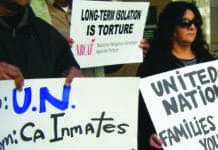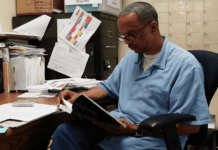
The Democratic governor’s unwillingness to release prisoners has allowed a viral conflagration which threatens the Bay Area and beyond.
by Anne Weills
Gavin Newsom, like many California governors before him, seems more interested in protecting a future run for president than the health and safety of the state’s most vulnerable populations, whether they be undocumented residents or prisoners in our state’s sprawling gulag. Being “tough on crime” while preserving a generally liberal reputation is the cynical balancing act.
This time that means more Californians will die, both inside and outside prison walls, because of Gov. Newsom’s stubborn unwillingness to adequately exert proper control and oversight of the California Department of Corrections and Rehabilitation (CDCR) in the midst of a once-a-century global health crisis. History will judge him harshly.
For months since COVID-19 arrived, health officials, lawyers, prisoner families and judges have been warning of a potential nightmare epidemic scenario in the state’s overcrowded prisons if aggressive measures, including paroling or releasing large numbers of nonviolent and elderly prisoners, were not taken. Now, with an explosion of cases spreading across the system, that moment has arrived.
A month ago, decrepit San Quentin State Prison in Marin County had no known cases of COVID-19, according to an investigation by the San Francisco Chronicle, until a disastrous, shockingly negligent transfer of 121 untested prisoners from the Chino prison, a pandemic hotspot. The move predictably spread the novel coronavirus, first to the general population and then to the 700 or so prisoners crowded into the facility’s Death Row, where a prisoner just died.
As of this writing on June 28, 815 San Quentin inmates have tested positive, according to CDCR, as well as at least 80 staff members, and the numbers are growing by the hour.
Apparently unable to learn, CDCR then inexplicably announced another transfer plan, to move approximately 150 men to North Kern State Prison, near Delano. This attempt to compound the crisis was abandoned only after, unsurprisingly, several of the men ticketed for the long bus ride tested positive.
Such reckless and shameful decisions by Ralph Diaz, the secretary of CDCR, and his counterpart, J. Clark Kelso, the head of the California Correctional Health Care system, to allow these transfers, as well as inadequate testing, social distancing and other health measures within the system, ultimately fall on Newsom as an unconstitutional human rights abuse and health threat to all of us; prisons, after all, are not bubbles, but rather perfect incubators for the spread of the acceleration of the pandemic.
We are months into this historic crisis without any significant action to improve the untenable situation. Instead, Newsom has unconvincingly argued that any major reduction in prison population would pose an unacceptable safety risk. More likely, he is unwilling to accept what he sees as a political risk to any future bid to run for president in a country perceived as less liberal than California.
“There are a lot of people who can be released without danger by anyone’s measure.”
More than 40 advocacy groups, including the American Civil Liberties Union, wrote Newsom asking him to free medically fragile adults and those over 60, as well as all inmates scheduled to be paroled through next year. These are modest, reasonable expectations of flexibility of the kind that have been undertaken in prison systems throughout the world since the scale of the pandemic has been grasped.
“There’s no need to release anybody who is dangerous to public safety,” Michael Bien, an attorney representing mentally-disabled prisoners, told the Chronicle. “There are a lot of people who can be released without danger by anyone’s measure.”
San Quentin, in particular, was always seen as an epidemiological tinderbox. In early June, a team of health experts from UC Berkeley and UC San Francisco warned prison officials they’d need to cut the population of San Quentin in half “to avoid a potentially catastrophic outbreak,” which could have “dire implications” for the greater Bay Area as the prison’s employees would likely spread the disease in their homes and communities. The group called both for the establishment of a field hospital and other immediate changes at the facility.
In fact, this was the last place prisoners should have been transferred: The crumbling prison, opened in 1852, retains ancient cells with bars, not doors, with air flowing openly between higher and lower tiers maximizing the potential spread of any illness. Reports from prisoners state that many staff are not wearing masks and/or implementing other standard safety precautions. The prison, which is at 150 percent of capacity, also sits at the crossroads of a megalopolis of nearly 8 million people, staffed by employees who commute home every night throughout the region.
After dozens of deaths and some 5,000 positive tests among inmates systemwide, it was not until this incriminating San Quentin episode that Newsom, closing the proverbial barn door, belatedly admitted on June 24 that more prisoners might need to be released.
Never mind that the state has had over four months to identify those who are elderly, immunocompromised or otherwise at heightened risk of severe COVID-19 symptoms and either release them or find a way to move them to less crowded, hazardous spaces. This reckless disregard for their safety is not just immoral, but also a possible violation of the Eighth Amendment of the U.S. Constitution, which forbids cruel and unusual punishment.
Well-intended federal judges Jon Tigar and Kimberly Jo Mueller have so far refused to order CDCR to release prisoners, citing the high bar of such a claim, which requires an evidentiary showing of deliberate indifference by CDCR. However, what could be a more compelling case of this than CDCR’s reckless transfers of infected prisoners done without testing, or unwillingness to enforce safety regulations on its own employees? Especially after so much has been learned about the spread of the disease by people not yet showing symptoms, these acts evidence a total disregard for human life, or worse.
Where is our allegedly progressive governor? Why isn’t he properly overseeing CDCR and playing a leadership role in protecting prisoner lives, instead of treating them as disposable? Maybe Gov. Newsom thinks those Californians who are not imprisoned don’t care about these people, but many of us do.
More than three months ago, Newsom used a strawman argument to block any significant change to the status quo at CDCR in response to the pandemic: “I have no interest – and I want to make this crystal clear – in releasing violent criminals from our system,” he said, despite nobody asking for that. “That’s not the way we will go about this. We will do it in a very deliberative way.”
That was in March. We are about to hit July, and Newsom and CDCR dithered when they needed to act. Now the conflagration threatens the wider community and San Quentin may become a charnel house.
The only way I can intellectually explain this negligence is that the governor lives in fear of future negative campaign ads against him when he inevitably runs for president.
Where is his courage?
Copyright ©2020 Anne Weills. Anne Weills is a civil rights attorney based in Oakland. She was co-counsel in Ashker v. Brown, et al., which successfully challenged the use of solitary confinement and indefinite detention in the Pelican Bay State Prison Security Housing Unit (SHU) and the lack of due process in which prisoners were assigned to the SHU. The Settlement Agreement is still being monitored by a magistrate judge. This story was originally published by ScheerPost, is copyrighted by the writer and is republished with permission.

 Store
Store












